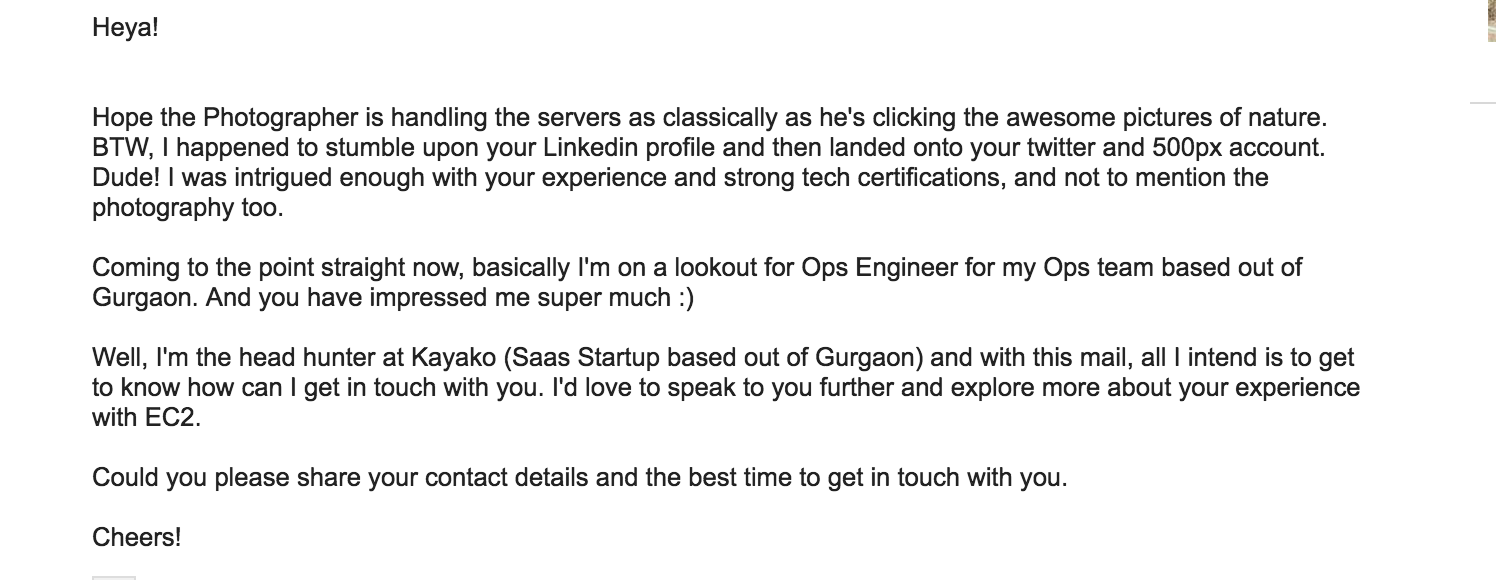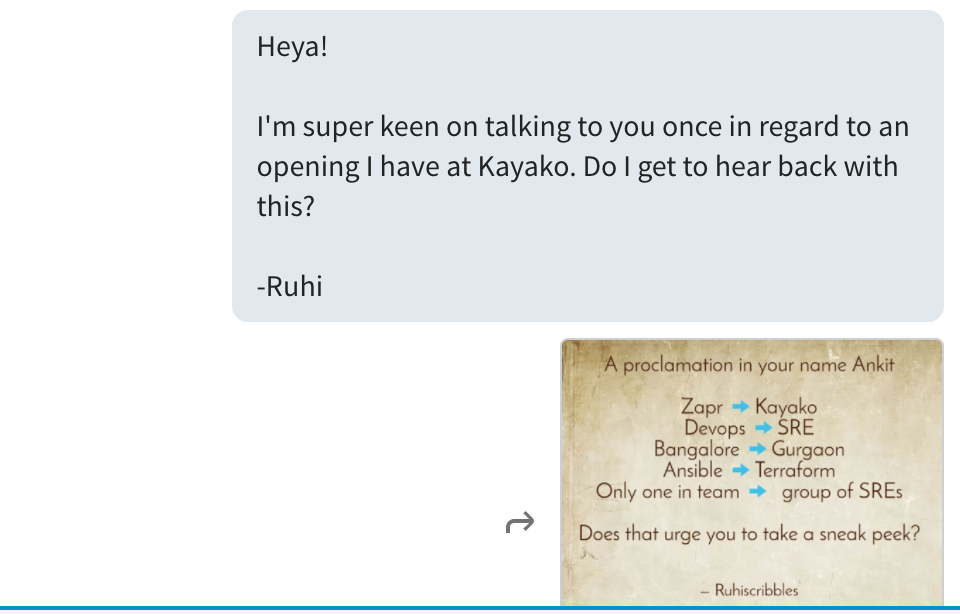If you’re a hiring manager in a startup you can agree with me when I say, It’s not easy to build a dream team with so many constraints.
Like every other startup these days, Kayako looks for self-starters and self-motivated candidates. Those are the baseline skillsets that make great employees.
Relying on applications alone can be difficult.
You can sit forever waiting for the right candidate to come in. Sometimes you’ve got to get out there and reach out to potential candidates yourself.
I take pride in saying that 90% of the current Tech team at Kayako’s Gurgaon office I had a hand in building. And 70-80% of those hires came from recruiting passive candidates.
3 step system to recruit passive candidates
Recruiting passive candidates is tough, but without a system, it’s even harder.
It takes a while to get used to proactively tracking, chasing, and pushing candidates to come for interviews.
And no matter how much passive recruiting you do, after all the tracking and chasing it’ll still hurt when you offer your candidate a job and they decide to turn you down because your company isn’t right for them. That can leave you feeling low like you never want to try passive recruiting again.
But through progressive learning and adjusting my strategies, I’ve built a system to know how to approach passive candidates and hire them almost every time:
1. Use the right tools to make thorough candidate research simple
2. Capture their attention by showing genuine interest
3. Persevere and sell them on the job
1. Finding your candidate: Search for companies that use the same tech stack.
Finding suitable candidates can be tricky. But a great approach to passive recruiting is finding candidates that use the same tech stack as your business.
Although we mainly hire candidates for their attitude, skill, and desire to progress, I typically start with finding a business that uses the same tech stack as us. Using the same tools isn’t everything, but as Engineering is the primary role I recruit for, having experience with the tools we use to build Kayako is vital.
Simply install either of these two tools, and go to a businesses website to see if they use the same platforms as you.
But other than those you can normally find out your answer if you dig around by:
- GitHub advanced search
- Scanning Quora answers, or asking the question yourself
- Glassdoor research
- StackOverflow
- Asking the people in your network
2. How to approach passive candidates: Show genuine interest
Once I think I’ve found a candidate I want to take a closer look at, I start my research from social media and references.
One Chrome extension that always comes to my rescue is Aevy. Aevy fetches you the email, Twitter, StackOverflow, GitHub links of the candidate and other platforms they might be active on. This tool allows me to conduct further research and get to know them before reaching out.

I span my search to their social media accounts. I make an effort to follow them on Twitter, Facebook, Instagram, or Snapchat. I try to stay up to date with their feeds. If they run a blog, I also keep tabs on that.
All this information helps me study and build a personalized way I can reach out to them. Building rapport is the goal in the early stage. It also allows me to craft a story and tell them how Kayako can fit into their professional life. Using the information from all of these places allows me to personalize my approach when I reach out to them.
Reach out to the candidate: Don’t use a script
As much as I’d like to hand you some email scripts for recruiting passive candidates. I have to be honest and say it’s more work to customize it to the individual than it is to write a unique, personalized email.
But this is the system I use to connect after my thorough research:
- Send out an email, and ping them on LinkedIn InMail (It’s not a script. There are a lot of things that change according to the research.)

I wait for 2-3 days for a reply. If nothing comes back I Tweet them and send them something personal via a scribble I put together.

If they’re nonresponsive to me reaching out, I try other platforms they use. It’s about being proactive and meeting these tech-savvy millennials where they hang out online.
It’s not always about email or InMail, engage with them on their favorite platform. I’ve hired passive candidates who hate talking but love texting. And I’ve been known to receive resumes on Whatsapp and put them in our applicant tracking software!
This is the point where they’re either non-responsive or they say they’re not interested in the job. If they respond and tell me, I give it another shot at convincing them. But if they’re really sure they don’t want the position, I go back to the first step and restart my search.
3. Perseverance: how to sell them on the job
Selling Kayako and the job happens right from the beginning, on the first touch via InMail or email. If the candidate is receptive to the passive recruiting techniques, and they show interest in the role, my aim is to schedule in a call and talk.
Get the candidate on the phone
Assuming that the candidate has read the Kayako website (and they know about Kayako customers, our bootstrapped story, number of customers, company age, etc.), I generally follow these 3 steps:
1. Sell the team’s culture: Whatever team you’re recruiting for, give the candidate an idea of how they would work in their new department and team. For deeper questions get them on the phone with the Director of the department (more on that in the next section).
When I’m selling Kayako’s coding culture, I tell them it’s a creative blend of automated and a peer review system. We use GitHub across all teams and ensure that each commit is reviewed by a peer. We have bots that allow you to ship your commit straight to various environments such as staging and production via a simple slack command.
2. Sell your workplace culture: Give the candidate an overall impression what it’s like to be an employee of your company. We pride ourselves on our people policies, to name a few we have work from home, unlimited paid time off, great stock options, and international locations (people either work from one of the two main offices, London or Gurgaon, or remotely from the US, Ukraine, Poland, Philippines, and more).
3. Invite them into the office: Once I’ve told the candidate all about Kayako, the job, and our culture, I prioritize getting them into the office so they can visualize themselves working there. I often round up the call saying: “We’d love it if you would visit our office – we’ll arrange the travel – to spend time with us, meet the team, and have a chat with us. Can you come in next week?”
If you can’t get them on the phone: For the few who aren’t contemplating a change, they need to be convinced by meeting them over coffee or lunch. There have been multiple instances I’ve gone to meet my prospects at the coffee shops near their house or office. Trust me that leaves them with almost no chance to say no to a quick catchup.
Get the candidate into your office
Once you’ve got the candidate into the office, this generally means they’re very interested in the job. But I follow these 4 steps to make sure I have the highest chance of recruiting successfully:
1. Get them to meet a Director as soon as possible: A Director is best suited to sell them on how the team runs, what their goals are, and answer any question they might have about working within that department.
We schedule our Engineering candidates to speak to with Kashif, Director of Engineering, over the phone. Kashif will give an explanation of the exact technical details an engineer would want to know about working in Kayako: goals, mission, and values.
2. Introduce them to your team: Candidates are keen on knowing who will they work with because they want to be associated with coworkers just as smart or smarter than them. Connecting them with the people with similar energy brought me better results.
As a bonus, my existing team referred their friends and I have had many closures through referrals.
But always seek your current teams help in screening candidates. The existing team has every right to choose who they work with. This, in turn, adds to my energy and love for hiring and the teams when great people are hired.
3. Show them there’s potential to grow: Everyone hates dead end jobs! The main objective should be mapping their career within your company. If you can show them a clear career ladder and progression they can make within your company, they are in.
4. Don’t forget to talk salary: My experience is with hiring millennials and they generally aren’t salary driven. They don’t necessarily want the best salary, but a fair salary.
But, once salary negotiations are done – and the compensation is usually resolved in one discussion – they are excited about this career move. A recruiter’s perseverance and role understanding is the key here!
What if they don’t want the job? When it comes to recruiting passive candidates, selling them on leaving their current role and taking the job you’re offering is the hardest part. There have been countless times where I have got to this stage only to have the candidate stay at their current company. This is frustrating and it hurts every time this happens.
The key is to review your system:
- Where are candidates dropping out of the pipeline?
- How can you iterate that section of your process because minor improvements can make a big difference?
For me, it was creating a personal connection that got big wins in my passive recruiting strategy.
Being personal is the most effective way to recruit passive candidates
There any many techniques, methods, and strategies out there to recruit passive candidates. But essentially it comes down to doing your research and creating a personal connection.
Think about it this way, when was the last time you bought something via your last cold sales call or unanticipated email that came into your inbox? We have to take this mentality into our recruiting methods.
Passive recruiting is about knowing who we’re talking to, turning them into a friend, and turning friends into employees. Yes, this is hard work, but this is a much better technique than outsourcing or InMail blasting on Linkedin.
When you put the effort in, you’ll be able to see the quality that you’ve hired and your team will thank you for that.